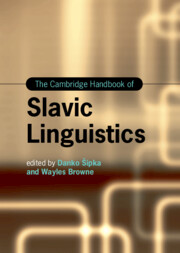Book contents
- The Cambridge Handbook of Slavic Linguistics
- Cambridge Handbooks in Language and Linguistics
- The Cambridge Handbook of Slavic Linguistics
- Copyright page
- Contents
- Figures
- Tables
- Contributors
- Introduction
- Part 1 Prosody and Phonology
- 1 Word Stress
- 2 Vocalism: The Vowels
- 3 Consonantism: The Consonants
- 4 Syllable Structure
- 5 Phonologically Conditioned Alternations
- 6 Prosodic Reflexes of Information Structure
- Part 2 Inflectional and Derivational Morphology
- Part 3 Syntax
- Part 4 Lexicon
- Part 5 Sociolinguistic and Geographical Approaches
- Part 6 Experimental and Quantitative Approaches
- Name Index
- Subject Index
- References
4 - Syllable Structure
from Part 1 - Prosody and Phonology
Published online by Cambridge University Press: 16 May 2024
- The Cambridge Handbook of Slavic Linguistics
- Cambridge Handbooks in Language and Linguistics
- The Cambridge Handbook of Slavic Linguistics
- Copyright page
- Contents
- Figures
- Tables
- Contributors
- Introduction
- Part 1 Prosody and Phonology
- 1 Word Stress
- 2 Vocalism: The Vowels
- 3 Consonantism: The Consonants
- 4 Syllable Structure
- 5 Phonologically Conditioned Alternations
- 6 Prosodic Reflexes of Information Structure
- Part 2 Inflectional and Derivational Morphology
- Part 3 Syntax
- Part 4 Lexicon
- Part 5 Sociolinguistic and Geographical Approaches
- Part 6 Experimental and Quantitative Approaches
- Name Index
- Subject Index
- References
Summary
This chapter provides an overview of Slavic syllable structure from both synchronic and diachronic perspectives. It begins by introducing some general phonological background on the syllable and reviewing key concepts, such as syllabification and sonority. The discussion further focuses on specific aspects of Slavic syllable structure: inventories of syllable-initial and syllable-final consonants and consonant clusters, and the composition of syllable peaks (vowels and syllabic consonants). This is done by situating patterns characteristic of Slavic in the context of cross-linguistic typology of syllable structure, as well as by highlighting common historical sources and more recently developed differences among individual Slavic languages. The chapter concludes with a short review of recent experimental and corpus work on Slavic syllable structure.
- Type
- Chapter
- Information
- The Cambridge Handbook of Slavic Linguistics , pp. 64 - 86Publisher: Cambridge University PressPrint publication year: 2024

